At the conclusion of “Rumstick Road,” a performance piece I saw many years ago, I approached author/performer Spalding Gray to ask him if he could expound on the meaning of a scene in the play. The scene involved a campsite that was positioned way upstage—away from the audience—to provide background for a monologue that had nothing to do with camping. His answer was that the image was chosen for its “painterly” aspect.
It was the first time I had heard the word painterly used as a way to describe something visually spontaneous or intuitive in another art form. As a student, I was unfamiliar with what was by then a common theoretical detachment of painting as an idea from the object typically seen hanging on a wall. And from that moment I was confident that the essence of painting had a stable position in the cultural landscape—a position that when recognized honestly was solid enough to put to rest the occasional attempt at pronouncing its demise. For it proved, at least to me, that painting was not only alive and well, it had apparently grown to the stature of an archetype for artistic expression.
Not surprisingly, that same form of expression gave rise to all manner of experiments that stretched actual paintings far beyond their traditional parameters. To begin with, they were stretched in regard to the mimetic role painting played prior to abstraction, and subsequently through the addition of materials and techniques associated with other disciplines, both artistic and industrial. Anything that produced a visual effect was appropriate for a painting.
Yet when one encounters a painting with no paint, the question still arises, why would an individual—assuming that individual has an affinity for painting itself—abandon traditional painting methods and assume the more sculptural disciplines of casting, carving or modeling? For a case in point, at the Richard & Dolly Maas Gallery on the SUNY Purchase campus in Upstate New York, an exhibition called “Physical Painting” presents the work of a dozen artists who for the most part use materials other than paint.
.
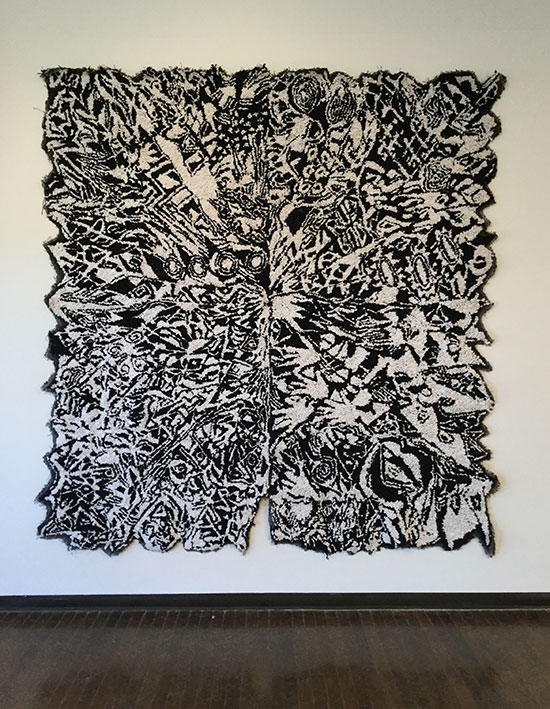
“White Rose, 2015” by Liv Aanrud. Flannel and burlap.
.
Curator Jennifer Samet suggests in her accompanying essay that the appeal alternative media holds for these artists is inseparable from their attitude toward their feeling for process. It is process that remains constant, whether an artist uses traditional or non-traditional methods. Moreover, as she stresses for these 12 artists, process is not referenced ideologically, as in the Process Art of the 1960s, but as “... an inevitable response to a 'post-studio' art culture in which making was devalued by theory.”
The curator insists that these artists do not focus on painting's physicality for the purpose of deconstructing the form, or to address residual dilemmas of mid-century formalist criticism, but because they are interested in painting's human scale, particularly in regard to, “ … the tactile and [to] craftsmanship.” And in many ways this is the perfect show for a college gallery. Installed as it is just down the hall from a thriving art department, it offers a refreshingly optimistic reading of one of contemporary art's more relevant dilemmas.
.

Installation with “Untitled, 2015” by Michelle Grabner (foreground). Color-aid and Arches paper.
.
“Physical Painting” suggests that young artists, who for pragmatic reasons are likely to be tethered to a college career, can successfully and enthusiastically maintain their independence from academia's tendency to bloat art theory to unrecognizable proportions.
The exhibition's participants range from youngish mid-career artists to active-yet-legendary elders, reinforcing the show's argument that physical painting's current ubiquity is both real and long-standing. The more senior participants, Larry Poons and Ron Gorchov—the former a restless challenger of his own ideas, the latter a soul of consistency behind endlessly reworked versions of the same solution—are represented with choices that fit well into the exhibition's thesis, though it must be said they also join a minority in the exhibition who still rely on paint.
The Poons canvas, Wilma Lee Cooper, 1999, is from a series of paintings in which he chose to create form that seems uncharacteristically well-defined. Still, this particular painting was probably chosen by Samet specifically for its prominent three-dimensional additives. Gorchov’s ERATO, 2012 is not only contemporary, but just the right size for its unusual shape to work its magic in the context of the show's scale and premise.
.
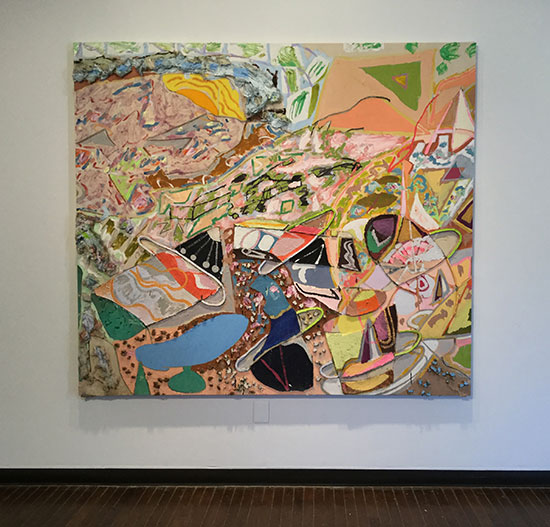
“Wilma Lee Cooper (99A-1), 1999” by Larry Poons. Acrylic on canvas. Courtesy of Loretta Howard Gallery and Danese/Corey Gallery. Installation photo by Peter Malone.
.

“ERATO" by Ron Gorchov, 2012. Oil on linen. Courtesy of John Cheim. Installation photo by Peter Malone.
.
David Lloyd offered an installation of sorts by preparing a canvas to fit into a narrow and unusually tall space near the gallery entrance. Made of a blend of applied rubber substances that appear in some places to have been ripped and torn from the surface, Purchase RDF, 2015 nevertheless looks more like a painting than much of the work submitted by the other artists.
.
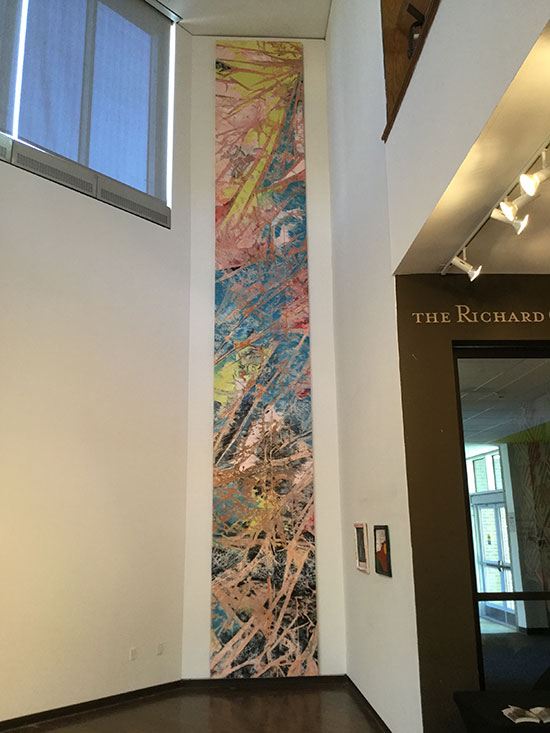
“Purchase RDF" by David Lloyd, 2015. Plastic and rubber on canvas. Photo by Peter Malone.
.
Cordy Ryman installed Baby Chimera, a smaller version of Chimera 45 shown last year at Zürcher Gallery's Bleecker Street space. Made as the earlier one was of mitered 2x4s grouped on square tiles, some partially painted with Dayglo red, others in a faded white—both alternating between panels of untouched plywood—it covers an entire section of a wall to the left of the reception desk. Yet its scale—one assumes established in concept for the Zürcher space—doesn't work as well here. Made of smaller lengths of the same basic material as the original, it seems wobbly and fragmented.
.
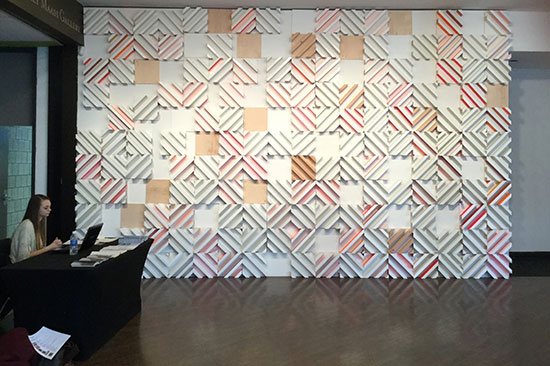
“Baby Chimera” by Cordy Ryman, 2016. Acrylic and enamel on wood. Installation photo by Peter Malone.
.
Hilary Harnischfeger's Black Eye, 2014 is the most intriguing piece in the show and the most consistent in the context of the show's premise. Apparently built of paper and board pressed into layers, with the label description adding the less obvious details of hydro-stone, mica, pigment, ink and amethyst, it is surprisingly painterly. After careful inspection, I managed to visually corroborate all but the amethyst. Perhaps it was ground into a pigment, which would explain the slightly purplish tint evident throughout the surface.
.
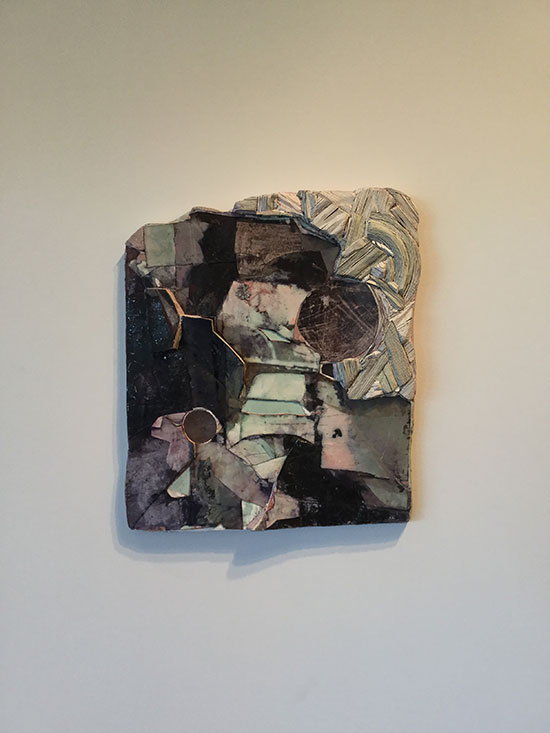
“Black Eye” by Hilary Harnischfeger, 2014. Paper, hydro-stone,pigment, ink, amethyst, mica. Courtesy of the artist and Rachel Uffner Gallery. Installation photo by Peter Malone.
.
Measuring about two feet in either direction, its primary appeal is its design. Harnischfeger can build a tight and complex composition worthy of comparison to de Kooning's Painting of 1948 in MoMA's collection. Though the planar tilting of the work’s many parts holds to a modest reiteration of cubist ideas, which risks an unfortunate banality, she ingeniously avoids the cliché by flipping the elements in the upper right area of the piece to reveal their cross-section. With its layering now exposed, a linear pattern adds yet another dimension to the already complex surface.
Dona Nelson's canvas and stretcher painting is supported by a metal stand that presents it as a screen between the viewer and the gallery window. Black Points, 2015 is designed to be seen from both sides, though the back fails to match in interest what the front view offers. The works of the remaining artists demonstrate the painterly qualities of fabric, color-aid paper, cast-then-carved plaster or cement, and two uses of fired clay: one as a paint support, the other in more traditional ceramic mode. Most of the works hang on walls, while a few are placed on low platforms nearly level with the floor.
.

“Black Points, 2015” by Dona Nelson. Acrylic and acrylic medium on canvas (two-sided). Courtesy of the artist and Thomas Erben Gallery. Installation photo by Peter Malone.
.
On balance, I was left with the feeling that regardless of what material an artist chooses to work with, abstraction is likely to produce a visually compelling result only if the artist can tease from the chosen medium a visual expression that transcends the viewer's expectations of the medium used. What “Physical Painting” demonstrates clearly is that it is no easier to get a successful painting from cement, paper, fabric or clay than it is from paint applied to a canvas.
Regardless of the materials used, abstraction—the most individual of all painting's genres--demands a commitment to a vision that often seems no clearer to the artist than to a viewer. If painters can lose themselves in the act of scratching into a block of plaster, something may come of it. In the end it is the artist's judgment of the result, not the recipe, that matters most.
__________________________________
BASIC FACTS: "Physical Painting" remains on view through March 18, 2016. The show was curated by Jennifer Samet with Scott Wolniak.
The Richard & Dolly Maas Gallery is located at the Visual Arts Building, Purchase College, SUNY, 735 Anderson Hill Road, Purchase, NY 10577. 914.251.6750, [email protected].
___________________________________
Copyright 2016 Hamptons Art Hub LLC. All rights reserved.
